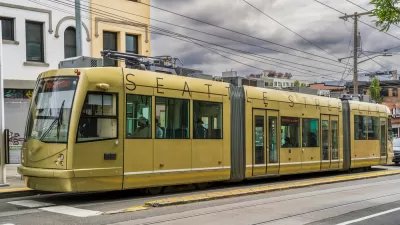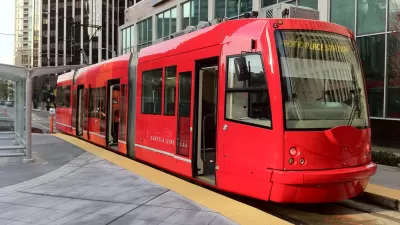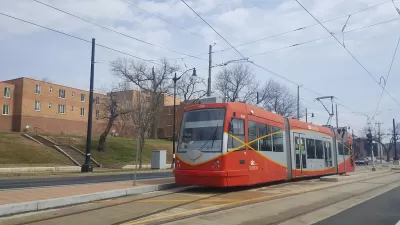Matt Fikse calls attention to a Seattle transit plan, which has few drawbacks but has been left to die by officials. Why the streetcar beat out the Rapid Trolley Network.
"Planners developed routes, cost estimates, and ridership projections for several alternatives. The summary, with the prosaic title 'Scenario Development Documentation, Portfolio 4.3', was included in the mountain of documents prepared for the Alaskan Way Viaduct Stakeholders group - to little notice. It is, for all intents, a road map for the Green Lines.
Its conclusions are breathtaking: Metro estimated that a Rapid Trolley Network would increase ridership by 60%, from 24 million to 38 million annual riders, while reducing overall emissions 60% over diesel buses and practically eliminating tailpipe emissions.
The kicker? The report calls the Rapid Trolley Network plan the best transit value in town, bar none: "The estimated marginal cost of $1.24 per new rider is lower than any other improvement." Total capital cost of the Rapid Trolley Network was pegged at $142 million including new passenger amenities, new extensions to Madison Park, connections to the Othello and Henderson Street light rail stations, new connector routes through the Central District, Downtown, and along Denny Way."
"Where has such a good idea gone? Nowhere, mostly. This underscores a problem with the deep-bore tunnel selection for the Viaduct replacement: ideas that had been associated with the Surface/Transit option - ideas with practical benefits independent of the tunnel - now seem to be on the back burner if not altogether dead."
FULL STORY: Good transit plan gone missing

Alabama: Trump Terminates Settlements for Black Communities Harmed By Raw Sewage
Trump deemed the landmark civil rights agreement “illegal DEI and environmental justice policy.”

Planetizen Federal Action Tracker
A weekly monitor of how Trump’s orders and actions are impacting planners and planning in America.

Why Should We Subsidize Public Transportation?
Many public transit agencies face financial stress due to rising costs, declining fare revenue, and declining subsidies. Transit advocates must provide a strong business case for increasing public transit funding.

Understanding Road Diets
An explainer from Momentum highlights the advantages of reducing vehicle lanes in favor of more bike, transit, and pedestrian infrastructure.

New California Law Regulates Warehouse Pollution
A new law tightens building and emissions regulations for large distribution warehouses to mitigate air pollution and traffic in surrounding communities.

Phoenix Announces Opening Date for Light Rail Extension
The South Central extension will connect South Phoenix to downtown and other major hubs starting on June 7.
Urban Design for Planners 1: Software Tools
This six-course series explores essential urban design concepts using open source software and equips planners with the tools they need to participate fully in the urban design process.
Planning for Universal Design
Learn the tools for implementing Universal Design in planning regulations.
Caltrans
Smith Gee Studio
Institute for Housing and Urban Development Studies (IHS)
City of Grandview
Harvard GSD Executive Education
Toledo-Lucas County Plan Commissions
Salt Lake City
NYU Wagner Graduate School of Public Service





























